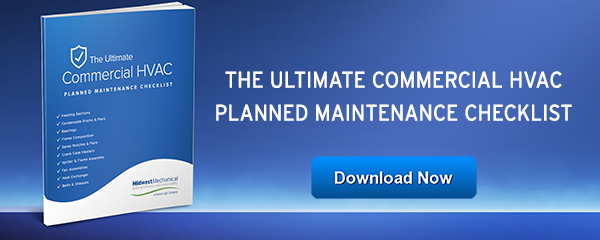How to Reverse 3 Common Commercial Heating and Cooling Problems
 Learning how to quickly diagnose and fix problems when they first appear rather than waiting until they get worse is a helpful and profitable skill to have when you’re trying to balance all the tasks inherent to managing a large commercial facility.
Learning how to quickly diagnose and fix problems when they first appear rather than waiting until they get worse is a helpful and profitable skill to have when you’re trying to balance all the tasks inherent to managing a large commercial facility.
To help you with that, we’re offering this quick, practical guide to identify and reverse three common commercial heating and cooling problems that can affect your Chicago building’s HVAC system:
Problem 1: Rising energy bills
Sometimes, a problem can only really be noticed when you review the financials. The system is probably still maintaining a comfortable temperature and good air quality throughout the building, but your monthly energy usage is rising with no simple explanation.
It could be that the system is no longer running efficiently due to an underlying problem, and is therefore using more energy to keep things comfortable. This can happen for many reasons:
- Equipment and ductwork are in need of cleaning
- Equipment is old and wearing down
- One or more components is broken or functioning poorly, requiring other components to compensate
- Electronic controls are broken or need to be recalibrated
Solution: It depends on what’s causing the issue
All of these issues have different solutions, so the best bet is to have a trained technician perform an operational assessment and inspection so they can properly identify the root cause(s) of the energy inefficiency that’s costing you money.
Installing a building automation and analytics system to control and monitor the HVAC can make this process faster and easier, but these systems can require a sizable investment, so it’s important to consider your current HVAC system’s health and lifespan first. One of the key benefits of “smart building” systems is the fact that machine learning and artificial intelligence can be used to continually optimize the system and make sure it’s running as efficiently as possible. The system can also make you aware of any issues as soon as they occur so you don’t need to wait until you see a shocking number on your next utility bill.
Problem 2: Strange noises in the walls or vents
Air flow vents that routinely make a lot of noise can be really annoying for tenants, clients, and customers. More importantly, unusual sounds in the vents can be indicative of problems in the system that aren’t readily visible. Some likely causes of noisy ventilation are:
- Loose or broken fan blades
- Pests getting into the ductwork
- Cracked or broken air ducts
In some cases, the sounds will come from the heating or cooling units themselves. If the unit is easy to access, you can confirm this if the sounds are louder near the unit, and if they correspond to what’s being heard in the vents.
Solution: Call in the pros to identify and resolve the problem
No matter where the sound is coming from, isolating and resolving the issue is likely to require expertise and equipment that’s not readily available. Your best option is to contact your local, trusted Chicago HVAC company to have an experienced technician assist with the problem.
Problem 3: Poor air quality
If you start getting complaints from part of the building about the air quality (i.e. being stuffy, humid, having an odd smell, or other similar issues), it’s a sign that maintenance may be needed on one or more of the air ducts serving that area. If the problem seems to be affecting most or all of the building, it’s more likely the problem is in the main heating or cooling unit itself.
Some common causes of poor air quality are:
- Air filters need to be cleaned
- Stagnant water collecting around units or in ventilation shafts
- Mechanical parts overheating
- Melted debris on the heat exchanger
The Solution: Routine maintenance
Strategically scheduled routine maintenance can usually catch all of these issues before they get bad enough to affect air quality. A comprehensive planned maintenance program includes visual inspections of the air ducts and mechanical equipment, along with tests to determine if any parts that aren’t readily visible require repair or replacement. Inspections are performed regularly, with no more than a few months between visits.
As a leading commercial HVAC company in Chicago, our trained and experienced technicians and energy engineers at Midwest Mechanical are eager to answer any questions you have, and to discuss the options available for avoiding these and other common problems with your commercial building’s HVAC system.

